This article has multiple issues. Please help improve it or discuss these issues on the talk page . (Learn how and when to remove these messages)
|
| 2018 Japan–South Korea radar lock-on dispute | |||||||
|---|---|---|---|---|---|---|---|
Video footage from the P-1 aircraft, released by the Japanese Ministry of Defense | |||||||
| |||||||
| Belligerents | |||||||
| Units involved | |||||||
| Strength | |||||||
1 destroyer 1 Coast Guard cutter | 1 maritime patrol aircraft | ||||||
- On 22 January, the South Korean MND released the formal statement summarizing their previous arguments explaining issues about the radar and the flight. The South Korean MND stated "The fundamental nature of this issue is the JMSDF patrol aircraft's threatening low-altitude flight towards the ROK Navy vessel that had been conducting a humanitarian rescue operation. ... We express our deepest regrets to Japan for discontinuing the working-level meetings without providing any decisive evidence. Along with the solid ROK-US Combined Defense Posture, our government will continue its efforts to strengthen security cooperation between the ROK and Japan despite the current incident." [46]
- On 23 January, according to the South Korean MND, a Japanese patrol aircraft flew at an altitude of 200–230 feet (61–70 m) within 1,800 feet (550 m) of a South Korean naval vessel on the afternoon of 23 January off Socotra Rock (Iŏdo) in the Yellow Sea, which lies some 100 miles (160 km) southeast of the South Korean island, Jeju. [50] The South Korean military called this action a "clear provocation" that "if such activity repeats again, our military will respond strongly based on our response rules." The Japanese Defense Minister denied the allegation, saying "the altitude of the Japanese aircraft claimed by Korea, 200–230 feet (61–70 m), is not accurate, we are properly recording our flight. The Japanese aircraft was flying higher than altitude of 150 meters, following the international and domestic law. [51] Japan Chief Cabinet Secretary Yoshihide Suga encouraged better communication between the military forces of the two countries. [52]
- On 24 January, the South Korean MND released 5 pictures taken by a camcorder and a thermal camera connected with a radar in the destroyer with recorded height and distance of the patrol plane. The South Korean MND explained that it detected the exact altitude and distance using a maritime surveillance radar. [53] [54] Japan stated that (regarding the photo with Japanese patrol aircraft P3C) it does not prove the altitude of the aircraft since the surface of the sea is not included in the picture. [55]
- On 25 January, the spokesperson of the South Korean MND, Choi hyon-su stated, "If Japan cannot trust our radar data that we revealed in yesterday, Japan should suggest more reliable evidence." [56] Japan stated "We have no reason or intention to threaten Korea's destroyer. If the two approaches, our patrol aircraft is not armed and the other is the destroyer, the unarmed will feel more threatened" [57] [58]
- On 27 January, the South Korean Minister of National Defense Jeong Kyeong-doo declared, "If we judge that Japan performed a provocative act again, we will respond strongly based on our domestic law," suggesting the use of weapons. [59]
- In February 2019, the ROKN was issued specific "Guidelines for responding to Japanese patrol planes", supplementing a set of more general "Guidelines for responding to aircraft from third countries" that had been adopted in January. The generic rules of engagement compiled by the South Korean military establishment had stipulated a four-step process in which aircraft that fly too close to an ROKN vessel are to be identified and then issued two successively harsher warnings by radio. However, the Blue House insisted on stronger measures specifically for Japanese planes, adding a fifth step in which aircraft that ignore the warnings are to be illuminated with fire-control radar. This caused consternation within the South Korean military, as it delegates too much authority and increases the risk of military conflict by leaving the decision to take potentially escalatory actions to the discretion of field commanders. Furthermore, it created a paradoxical situation, prescribing more severe measures against Japanese aircraft than those of Russia and China, countries that have previously violated South Korean airspace and made incursions into its air defense identification zone respectively. [60] [61]
- On 1 June, Japanese Defense Minister Takeshi Iwaya expressed his decision to end talks about the dispute to the South Korean Minister of National Defense Jeong Kyeong-doo. While both defense ministers could not reach a conclusion together, both have pledged to make to efforts to improve relations between the two countries. [62]
2022
On 17 November 2022, the ROK Navy claimed that it had not irradiated radar. [63]
2023
On 4 June 2024, Japanese Defense Minister Yasukazu Hamada and South Korean Defense Minister Lee Jong-sup held talks as part of the Shangri-La Dialogue in Singapore and agreed to accelerate working-level discussions to resolve the radar dispute, with a focus on outlining "steps to prevent a recurrence". [64]
2024
On 2 June 2024, Japanese Defense Minister Minoru Kihara and South Korean Defense Minister Shin Won-sik met on the sidelines of the Shangri-La Dialogue and agreed to normalize relations between their respective militaries and resume defense cooperation and exchanges. Characterizing the radar lock-on dispute as an obstacle to security cooperation between Japan and South Korea, as well as tripartite cooperation with the United States, the two countries released a document detailing measures to prevent a recurrence of the incident. In the document, the JMSDF and the South Korean navy undertook to comply with the Code for Unplanned Encounters at Sea, and agreed to improve communications and build trust. No mention was made regarding the exact chain of events in the 2018 incident, effectively putting the matter to rest. [65] [66] [67]
Views and opinions
Toshio Tamogami, a retired general and ex–chief of staff of the JASDF, has given his views on Twitter denying the offensiveness of aiming FC radar. [68] However, Toshiyuki Ito, a retired JMSDF admiral and ex-commandant of the Joint Staff College, rebutted Tamogami's view since the former had been retired for ten years and has no experience as a pilot. [69]
The South Korean government claimed this flight of P-1 was menacing and unfriendly to the warship of a neighboring country which was operating a rescue mission in the high seas. According to the South Korean government, it was Japan and not South Korea that acted improperly in this incident and should apologize. [70] However, Paul Giarra, a retired U.S. naval aviator and ex-senior Country Director for Japan in the Office of the ASD (ISA), pointed it out that there was absolutely no danger in the actions of the Japanese aircraft. [71]
Some South Korean media were concerned about the friction between Seoul and Tokyo. On 7 January 2019, a JoongAng Daily editorial argued that the two governments "should join forces to address the nuclear threats from North Korea and other urgent issues" and that "This emotional fighting does not help. Though what really happened at the moment has not yet been found, either side did not suffer substantial damage. Therefore, if [the South] Korean destroyer really aimed its FCR at the approaching airplane, our military authorities should apologize to Japan and wrap up the case. If the Japanese aircraft was really confused about the radar signal, it should apologize", and that "[i]t is time to take a deep breath and find a reasonable solution". [72]
While there is no international law regulating the altitude of military flights, Japan, the U.S. military, and NATO assert they follow the custom of the International Civil Aviation Organization (ICAO) to keep a distance of 150 meters (490 ft) from vessels under normal operations. [73]
See also
Related Research Articles
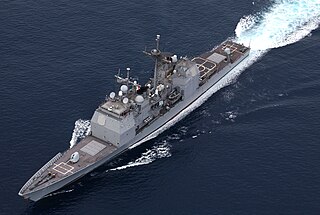
The Aegis Combat System is an American integrated naval weapons system, which uses computers and radars to track and guide weapons to destroy enemy targets. It was developed by the Missile and Surface Radar Division of RCA, and it is now produced by Lockheed Martin.
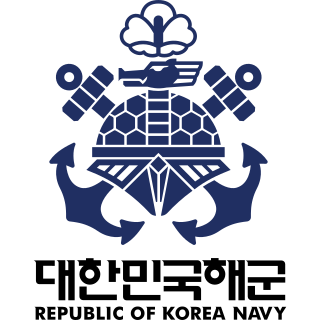
The Republic of Korea Navy, also known as the ROK Navy or South Korean Navy, is the naval warfare service branch of the South Korean armed forces, responsible for naval and amphibious operations. The ROK Navy includes the Republic of Korea Marine Corps, which functions as a branch of the Navy. The ROK Navy has about 70,000 regular personnel including 29,000 Republic of Korea Marines. There are about 140 commissioned ships in the ROK Navy. The naval aviation force consists of about 70 fixed-wing and rotary-wing aircraft. The ROK Marine Corps has about 300 tracked vehicles including assault amphibious vehicles.

The Japan Maritime Self-Defense Force, abbreviated JMSDF, also simply known as the Japanese Navy, is the maritime warfare branch of the Japan Self-Defense Forces, tasked with the naval defense of Japan. The JMSDF was formed following the dissolution of the Imperial Japanese Navy (IJN) after World War II. The JMSDF has a fleet of 154 ships, 346 aircraft and 50,800 personnel.
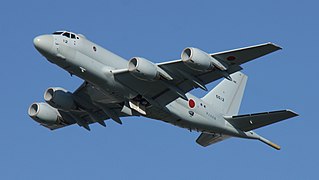
The Kawasaki P-1, previously P-X, XP-1, is a Japanese maritime patrol aircraft developed and manufactured by Kawasaki Aerospace Company. Unlike many maritime patrol aircraft, which are typically conversions of civilian designs, the P-1 is a purpose-built maritime aircraft with no civil counterpart and was designed from the onset for the role. It has the distinction of being the first operational aircraft in the world to make use of a fly-by-optics control system.
The Republic of Korea Navy was founded on November 11, 1945 as Marine Defense Group after Korea was liberated from the Empire of Japan. The ROK Navy is the oldest service within the ROK Armed Forces. In 2015, the South Korean navy celebrated its 70th anniversary.

The Mitsubishi H-60 series is a twin-turboshaft engine helicopter based on the Sikorsky UH-60 helicopter family for use by the Japan Self-Defense Forces (JSDF).
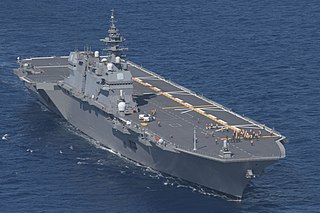
The Izumo-class destroyers are helicopter destroyers in service with the Japan Maritime Self-Defense Force (JMSDF). The official classification of these ships is DDH, which is accepted by the United States Naval Institute; in contrast, Jane's Fighting Ships describes this official classification, but the classification is simply "helicopter carrier".

JS Ōnami (DD-111) is the second vessel of the Takanami-class destroyers of the Japan Maritime Self-Defense Force (JMSDF).

JS Sazanami (さざなみ) is the fourth vessel of the Takanami-class destroyers of the Japan Maritime Self-Defense Force (JMSDF).

JS Izumo (DDH-183) is a helicopter carrier which, as of 2022, is being converted into a light aircraft carrier. Officially classified as a multi-purpose operation destroyer, she is the lead ship in the Izumo class of the Japan Maritime Self-Defense Force (JMSDF). She is the second warship to be named for Izumo Province, with the previous ship being the armored cruiser Izumo (1898).
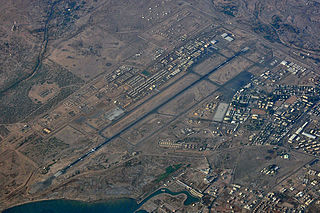
The Japan Self-Defense Force Base Djibouti is a military base operated by the Japan Self-Defense Forces (JSDF) located in Ambouli, Djibouti alongside the Djibouti–Ambouli International Airport.

The Japanese arms-export ban, known as the Three Arms Exports Ban, was a de facto law that governed Japanese export of military hardware outside of the country. The export ban was eased on 1 April 2014 by Shinzo Abe during his second term as prime minister.

The Maya class of guided-missile destroyers in the Japan Maritime Self-Defense Force is a modified version of the Atago class, with an updated Aegis Combat System and electric propulsion system. Maya was commissioned on March 19, 2020. Haguro was commissioned on March 19, 2021.

The Mogami-class frigate, also known as 30FFM, 30FF, 30DX, or 30DEX, is a Japanese multi-mission stealth frigate for the Japan Maritime Self-Defense Force (JMSDF).

Both the Japan Maritime Self-Defense Force (JMSDF) and the Japan Coast Guard (JCG) has hosted Fleet Reviews on a regular basis in Sagami Bay since 1956. The fleet review continues the tradition of triennial fleet reviews held by the Imperial Japanese Navy from 1868 to 1940.

ROKS Marado (LPH-6112) is the second ship of the Dokdo-class amphibious assault ship of the Republic of Korea Navy.

JS Abukuma (DE-229) is the lead ship of the Abukuma-class destroyer escorts. She was commissioned on 12 December 1989.
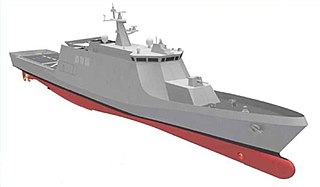
The Next-Generation Offshore Patrol Vessel (OPV) program consists of a planned 12 OPV-type patrol vessels to be operated by the Japan Maritime Self-Defense Force (JMSDF).
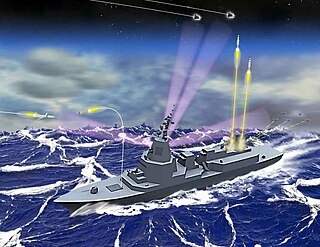
Aegis system equipped vessels (ASEV) or (Japanese: イージス・システム搭載艦) are a pair of ballistic missile defense (BMD) warships under construction to be operated by the Japanese Maritime Self-Defense Force (JMSDF) as dedicated sea-based BMD platforms, serving as an alternative to Japan's now-cancelled land-based Aegis Ashore BMD system.
References
- ↑ "Regarding the incident of an ROK naval vessel directing its fire-control radar at an MSDF patrol aircraft". Archived from the original on 28 December 2018. Retrieved 2 July 2021.
- ↑ ""한국군함, 자위대 초계기에 '사격통제 레이더' 쐈다" 일본 거센 항의". 21 December 2018.
- 1 2 "Regarding the incident of an ROK naval vessel directing its fire-control radar at an MSDF patrol aircraft". Ministry of Defense. 21 December 2018. Archived from the original on 11 April 2021. Retrieved 25 January 2019.
- 1 2 "Japan releases footage of South Korean destroyer's radar lock-on on JMSDF patrol plane". Naval Today.com. 28 December 2018. Retrieved 25 January 2019.
- ↑ Kajimoto, Tetsushi; Shin, Hyonhee (21 December 2018). "Japan accuses South Korea of 'extremely dangerous' radar lock on plane". Reuters . Archived from the original on 21 December 2018. Retrieved 25 January 2019.
- 1 2 "Regarding the incident of an ROK naval vessel directing its fire-control radar at an MSDF patrol aircraft". Ministry of Defense. 22 December 2018. Archived from the original on 11 April 2021. Retrieved 10 January 2019.
- 1 2 3 "Japan shows video of alleged radar lock-on by SKorea warship". The Washington Post . 28 December 2018. Retrieved 31 December 2018.[ dead link ]
- ↑ Forecast International (May 2013). Radar Forecast -MW08 (PDF) (Report).
- ↑ "[기획 한국군 무기 37] 해군 최초의 '방공구축함' 광개토대왕급". 31 May 2010.
- ↑ "한국-일본, '초계기 레이더 조준' 진실공방 격화". mbn.mk.co.kr (in Korean). 2 January 2019. Retrieved 22 January 2019.
- ↑ "일본 레이더 공세에 軍 영상 맞불…대치 심화되나 [박수찬의 軍]". 일본 레이더 공세에 軍 영상 맞불…대치 심화되나 [박수찬의 軍] (in Korean). 5 January 2019. Retrieved 22 January 2019.
- ↑ 윤, 상호; 서, 영아 (22 December 2018). "[단독]해군, 동해 표류 北어선 구조… 日 "韓 레이더, 우리 초계기 조준"" [[Exclusive] Navy rescues North Korean fishing vessels drifting in the East Sea... Japan "Korean radar aims at our patrol aircraft"]. The Dong-a Ilbo . Retrieved 7 March 2021.
- ↑ "광개토대왕함 사건은 일본의 기획도발?". The Dong-a Ilbo (in Korean). 29 December 2018. Retrieved 22 January 2019.
- ↑ "Sea Around Us | Fisheries, Ecosystems and Biodiversity".
- ↑ "Japan and South Korea's Unnecessary Squabble". thediplomat.com. 12 January 2019. Retrieved 23 January 2019.
- 1 2 "Regarding the incident of an ROK naval vessel directing its FCR at an MSDF patrol aircraft". Ministry of Defense. 28 December 2018. Archived from the original on 31 December 2018. Retrieved 3 January 2019.
- ↑ 김, 귀근 (28 December 2018). "레이더사건 진실은?…빔 쐈는지, 위협비행했는지 놓고 韓日 팽팽". Yonhap News Agency . Retrieved 7 March 2021.
- ↑ "Press Release: Regarding the incident of an ROK naval vessel directing its fire-control radar at an MSDF patrol aircraft". www.mod.go.jp. Japan Ministry of Defense. 21 December 2018. Archived from the original on 11 April 2021. Retrieved 22 January 2019.
- ↑ "Japan accuses South Korea of 'extremely dangerous' radar lock on plane". Reuters . 21 December 2018. Archived from the original on 21 December 2018. Retrieved 31 December 2018.
- 1 2 "Types of Radars and its Characteristics" (PDF). Ministry of Defense (Japan) . 28 December 2018. Archived from the original (PDF) on 30 December 2018. Retrieved 30 December 2018.
- ↑ "South Korea denies warship locked FCR on Japanese plane" . Independent . 25 December 2018. Archived from the original on 1 May 2022. Retrieved 31 December 2018.
- ↑ "Korea's military rejects claim of targeting Japanese patrol aircraft". The Korea Herald . 23 December 2018.
- ↑ "네이버 뉴스".
- ↑ "한국을 대표하는 글로벌 방송! The World on Arirang!". Archived from the original on 5 January 2019. Retrieved 5 January 2019.
- ↑ Panda, Ankit. "Japan, South Korea in Row Over Alleged Radar-Lock Incident". The Diplomat . Retrieved 30 December 2018.
- ↑ "Press Release: Regarding the incident of an ROK naval vessel directing its fire-control radar at an MSDF patrol aircraft". www.mod.go.jp. Japan Ministry of Defense. 25 December 2018. Archived from the original on 11 April 2021. Retrieved 22 January 2019.
- ↑ "김종대 의원 "일본 극우층이 한국에 의식적으로 도발"" [National Assembly Member Kim Jong-Dae, "Japan's LDP Party Convicts Korea"]. Chungcheong Today (in Korean). Retrieved 30 December 2018.
- ↑ Ministry of Defense (27 December 2018). Announcement of Japan-Republic of Korea Working-Level Meeting (Report). Archived from the original on 11 April 2021. Retrieved 2 July 2021.
- ↑ Moonkwan Kim (29 December 2018). "Japan denied to reveal ESM recorder". The Chosun Ilbo (in Korean).
- ↑ Makino Yoshihiro (8 January 2019). "Republic of Korea refuses to provide data Evidence of radar irradiation". Asahi Shimbun (in Japanese).
- ↑ "S. Korea, Japan hold talks over radar strife". Yonhapnews.
- ↑ "Video release represents Abe's political intention". The Korea Times . 30 December 2018.
- ↑ "Korea voices 'deep concern, regrets' about Japan's footage release amid radar spat". The Korea Herald . 28 December 2018.
- ↑ "South Korea demands apology from Japan for flight over navy warship". The Japan Times . 2 January 2019. Retrieved 3 January 2019.
- ↑ "Top diplomats of S. Korea, Japan agree to pursue future-oriented ties amid radar spat". The Korea Herald . 3 January 2019.
- ↑ "Japan ready to exchange radar records with South Korea over maritime lock-on incident". The Japan Times . 9 January 2019.
- 1 2 3 MoD (21 January 2019). MOD's final statement regarding the incident of an ROK naval vessel directing its fire-control radar at an MSDF patrol aircraft (PDF) (Report). Archived from the original (PDF) on 21 January 2019. Retrieved 21 January 2019.
- ↑ "Extended conflict between Japan and S.Korea". Financial news (in Korean). 16 January 2019.
- ↑ "국방부 "日, 광개토함 전체 레이더정보 요구…대단히 무례"". 15 January 2019.
- ↑ "S. Korea, Japan Fail to Narrow Differences on Radar Incident". world.kbs.co.kr. Retrieved 22 January 2019.
- ↑ "Japan, S.Korea remain split over radar incident". NHK WORLD. NHK. 15 January 2019. Archived from the original on 15 January 2019. Retrieved 22 January 2019.
- ↑ Makino Yoshihiro; Shinichi Fuziwara (15 January 2019). "Korea "Japan is rude and non-gentleman" conflict in negotiations over radar issues". The Asahi Shimbun (in Japanese).
- ↑ Makino Yoshihiro (16 January 2019). "South Korea "If Japan fly low-flying we also" radar irradiation problem". The Asahi Shimbun (in Japanese).
- ↑ "No resolution on the Radar spat". Yonhap News Agency . 16 January 2019. Retrieved 22 January 2019.
- ↑ "Extended radar spat...Japan: Disclosure of the sound file vs ROK: Japanese file is not provable". Herold Economics (in Korean). 21 January 2019.
- 1 2 Statement of Korean MND regarding the incident about Japanese patrol plane (Report). Korean Ministry of National Defense. 22 January 2019. Archived from the original on 25 January 2019. Retrieved 25 January 2019.
- ↑ "Japan revealed RWR record...continuous dispute between Japan and S.Korea". Yonhap News Agency (in Korean). 21 January 2019.
- ↑ "Entire story of the incident is on the log files". Kyunghyang Shinmun (in Korean). 21 January 2019.
- ↑ "Japan stopped negotiations. The South Korean MND expressed "Deep regret"". Seoul News (in Korean). 22 January 2019.
- ↑ "Accusations fly between South Korea and Japan over 'threatening' maritime maneuvers". 24 January 2019.
- ↑ P3C、「高度150メートル以上を確保」=岩屋防衛相の会見要旨. Jiji Press . 23 January 2019. Archived from the original on 30 January 2019. Retrieved 30 January 2019.
- ↑ Tong-Hyung, Kim (23 January 2019). "Seoul accuses Japanese patrol plane of threatening flight". The Washington Post . Archived from the original on 24 January 2019. Retrieved 25 January 2019.
- ↑ "軍, 日 초계기 위협비행 사진 공개.."기계는 거짓말 안 해"".
- ↑ ""machines never lie"...The pictures show show the red circle on the plane". MBC News (in Korean). 24 January 2019.
- ↑ "S. Korean MND released images of JSDF's "threatening flight"". Sankei Shimbun News (in Japanese). 24 January 2019.
- ↑ "MND requested more relible evidence from Japan". Yonhap News Agency (in Korean). 25 January 2019.
- ↑ "Japan,"We are not going to reveal the data"". Yonhap News Agency (in Korean). 25 January 2019.
- ↑ "The threatened is our patrol plane". TV Asahi (in Japanese). 25 January 2019.
- ↑ ""日 추가 도발 시 강력 대응"…軍, 무기 가동 검토". MBC news (in Korean). 27 January 2019.
- ↑ 이, 철재 (18 August 2022). "[단독] 문정부 "일본 초계기에 추적레이더 쏴라"…사실상 교전 지침" [[Exclusive] Moon administration: “Direct tracking radar at Japanese patrol planes” — de facto engagement guidelines]. JoongAng Ilbo (in Korean). Retrieved 17 June 2024.
- ↑ Suzuki, Takuya; Matsuyama, Naoki (19 August 2022). "Seoul drafted radar guidelines in 2019 targeting only SDF aircraft". Asahi Shimbun. Retrieved 17 June 2024.
- ↑ Tachikawa, Tomoyuki (1 June 2019). "Japan hints at ending talks about radar lock-on issue with S. Korea". Kyodo News. Retrieved 12 May 2020.
- ↑ 韓国国防部 海自哨戒機への「レーダー照射はなかった」. Yonhap News Agency (in Japanese). 17 November 2022. Archived from the original on 17 November 2022.
- ↑ "Japan, South Korea to speed up talks over pending military issues". Reuters. 4 June 2023. Retrieved 17 June 2024.
- ↑ Kobara, Junnosuke (2 June 2024). "Japan, South Korea move past radar row to improve defense ties". Nikkei Asia. Retrieved 17 June 2024.
- ↑ Tajima, Nobuhiko (2 June 2024). "Japan, S. Korea shelve row over 'radar lock-on' for better ties". Asahi Shimbun. Retrieved 17 June 2024.
- ↑ Tamura, Naohiro; Koike, Kazuki (2 June 2024). "Japan, South Korea to Resume Defense Exchanges After Agreeing to Measures to Prevent Repeat of 2018 Radar Incident". The Japan News. Yomiuri Shimbun. Retrieved 17 June 2024.
- ↑ 田母神氏投稿で物議 韓国照射"火器管制レーダー"の安全性 [Mr. Tamogami's controversial tweets and the safety of the FCR irradiated by South Korea]. Nikkan Gendai (in Japanese). 27 December 2018. Retrieved 8 January 2019.
- ↑ レーダー照射は「危険ではない」元海将が田母神俊雄氏の発言を全否定 [Former admiral refuted Mr. Tamogami's statement about the risk of Korean radar irradiation]. Tokyo Sports (in Japanese). 7 January 2019.
- ↑ "Korea continues to demand Japan's apology over radar row". The Korea Herald . 2 January 2019.
- ↑ ""No dangerous movement on the Japanese side" US experts analyzed videos". TV Asahi (in Japanese). 5 January 2019. Archived from the original on 3 February 2019.
- ↑ "Time to end this spat with Japan (KOR)". JoongAngDaily. 7 January 2019.
- ↑ 韓国国防省、写真5枚を公開「威嚇飛行」 日本は否定. Asahi Press (in Japanese). 24 January 2019.
External links
| Japan–South Korea radar lock-on dispute South Korean Navy radar lock-on incident | |||||
|---|---|---|---|---|---|
| Japanese name | |||||
| Kanji | 韓国海軍レーダー照射問題 | ||||
| Hiragana | かんこくかいぐんレーダーしょうしゃもんだい | ||||
| |||||
Shipwrecks and maritime incidents in 2018 | |
|---|---|
| Shipwrecks |
|
| Other incidents |
|


